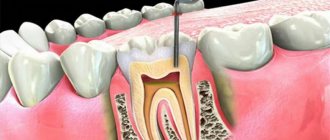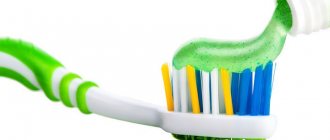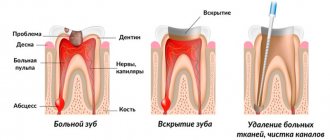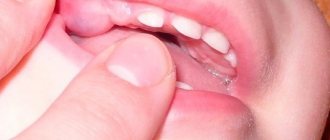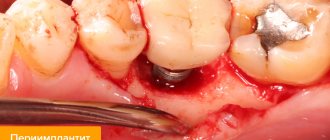Tooth preparation is one of the stages of orthopedic treatment. This is a necessary procedure in preparation for the installation of crowns, core inlays and veneers. Its essence is to remove part of the hard tissue to give the dental units the desired shape and securely fix the dentures. It is easily tolerated as it is performed using anesthesia. If teeth are severely damaged, they are usually depulped. However, most dentists try to preserve the pulp, as it is responsible for blood supply and tissue nutrition.
Do your teeth ache after grinding? Does pain interfere with eating, talking and falling asleep? Find out why discomfort occurs after preparing for prosthetics and how to get rid of them.
Causes of pain after turning
Discomfort in the oral cavity after partial removal of enamel and dentin is common. If the pulp has not been removed, the prepared tooth may be painful for 3-7 days. Unpleasant sensations worsen when drinking cold and hot drinks, hard foods, sour foods and sweets. This is a normal option, since increased sensitivity is due to thinning of hard tissue.
The cause of pain may be a violation of the teeth preparation technique. If the doctor worked without stopping, tissue overheating could occur. In this case, unpleasant sensations occur throughout the day, and not just in response to external stimuli. Pain can also be associated with removing too thick a layer of dentin and exposing the nerve of the tooth. The only solution to the problem is to remove the pulp.
After grinding, not only the tooth, but also the gums may hurt if a retraction thread was used during the procedure. It pushes back the edge of the gum and often injures it.
Why does a tooth hurt under a crown: reasons
Thus, if you have a toothache under the crown or the gums under the crown are inflamed, the reason almost always lies in poor-quality therapeutic preparation of the tooth for prosthetics. Of course, in most cases, dental therapists take control photographs after filling the canals, but even if they see mistakes, most doctors simply will not waste time and redo something.
Unfortunately, this approach in Russia is the norm rather than the exception. And if your tooth hurts under the crown, then the first thing you should do is an x-ray, which will show one of the main mistakes that dentists make when filling root canals. The image will show whether the tooth can be treated or whether it needs to be removed. The most common mistakes made by doctors include...
Root canals are not filled to the root apex –
Let us remind you that in most cases, teeth must be depulped before prosthetics. Depulping a tooth means that the dental pulp (neurovascular bundle) is removed from it and the root canals are filled. When filling root canals, there are certain standards, the implementation of which helps prevent subsequent inflammation in the area of the tooth roots.
In Fig. 1,2 you can see how well-filled root canals look on radiographs. However, when the doctor does not work and fills the canals not to the top of the root, conditions are created in the unsealed part of the canal for the spread of infection. Failure to fill the canal by just 1-2 mm can already cause inflammation at the apex of the tooth root (Fig. 3).
On X-ray 3 you can clearly see the unfilled part of the root canal (it is shown by a white arrow). Black arrows show the boundaries of a periodontal abscess, which on an x-ray looks like intense darkening in the area of the root apex. The reason for its formation is the development of infection in the unfilled part of the root canal. This dental disease is called periodontitis.
What does inflammation of a tooth look like under the crown (Fig. 4) –
- "Gutta-percha" is a material for canal filling,
- “periapical abscess” is a focus of purulent inflammation in the form of a purulent sac at the apex of the root (depending on the size of the purulent focus, the latter is called either a granuloma or a radicular cyst).
Poor obturation of root canals –
Inflammation can also be caused by poor obturation of the root canal with filling substances (gutta-percha and sealer). Those. the canal can even be sealed to the top of the root, but it is not sealed tightly, with many pores and empty spaces.
This could also be the reason why your tooth hurts under the crown, because... Such poor-quality canal filling also leads to the development of inflammation at the apex of the tooth roots. Poor canal obturation can also be easily determined by a targeted photograph of the tooth.
Perforation of the walls of the root canal –
Perforation is literally “a non-physiological hole.” In other words, this is a hole in the root of the tooth that is created artificially. The only physiological hole in the tooth is at the top of each root. The most common perforations that occur are:
- During instrumental treatment of root canals - using tools for mechanical expansion of the root canal, the doctor can make a number of mistakes. For example, instead of expanding the root canal along its course (from the mouth of the canal to the apex of the root), the doctor will direct the instrument perpendicularly through the canal wall, which will lead to the appearance of a “hole” in the root wall (Fig. 5, 6).
- During fixation of the pin in the root canal, doctors also very often allow perforations if the technique for fixing the pins in the root canal is not followed. Such perforations are also determined by radiographs and corresponding symptoms (Fig. 7).
Fracture of an instrument in the lumen of the root canal –
This happens quite often, but in most cases it is again due to the fault of the doctor. Below you will read about the main reasons for instrument failure in the canal. The only good reason for a breakdown that cannot be blamed on the dentist is if your root canals have a very severe curvature.
- Violation of the technique of rotating the instrument in the root canal - instruments for treating root canals are quite thin and require strict adherence to a certain technique of use. For example, most instruments cannot be rotated more than 120 degrees in the root canal. If the instrument is rotated 360 degrees in the root canal, this can naturally cause a fracture of the instrument, which is associated with the curvature of the root canals.
- Reuse of instruments—breakage of instruments can also occur due to the fact that the doctor uses “old instruments.”
Instruments for mechanical expansion of root canals are made of special metal. Any metal gets microcracks during loading, which is called “metal fatigue.” Repeated use of an instrument for root canal treatment greatly increases the risk of instrument breakage (24stoma.ru). Tools for canal treatment come in different sizes and differ in thickness. The thinnest instruments have sizes No. 6,8,10, 15. In Europe and the USA, such instruments are generally disposable and their reuse is not allowed. Instruments of other sizes can be reused after sterilization. But in Russia, in the vast majority of clinics, in order to save money, no one throws away such instruments, and they work with them “to the limit.” What affects the incidence of tool breakage. - When working in highly curved, difficult-to-pass channels - In this case, instrument failure may occur through no fault of the doctor, because
Instrumentation in such root canals is itself risky. But you cannot refuse and not do it. The presence of a foreign body (piece of instrument) in the root canal or beyond can be determined using an x-ray (Fig. 8, 9). And the problem here is that in most cases it is not possible to remove the instrument fragment from the canal. This prevents high-quality filling of the root canal, which in the vast majority of cases leads to inflammation developing, the tooth under the crown aching, or the gums under the crown hurting.
When is a doctor needed?
If your teeth ache for longer than 7 days after grinding, you should make an appointment with your doctor. The reason for contacting a specialist may also be:
- inflammation and bleeding of gums,
- the appearance of neoplasms on the mucous membrane,
- bad breath,
- pain when chewing and brushing teeth.
The listed symptoms cannot be ignored. Even with minor discomfort, it is better to consult a doctor to exclude the development of serious diseases.
What will the new prosthesis be made of and how will it be secured?
As for veneers, they are usually made of ceramics and its modifications - nanoceramics, ceramic composite, leucite ceramics (glass ceramics), ceramics reinforced with zirconium or aluminum dioxide. Veneers are attached with a special adhesive composition. And you need to understand that the thickness of the new veneer will be the same as that of the old one - so that the restored tooth does not “sink” into the row and does not protrude from it.
Now let's focus on crowns and bridges. The most suitable materials are recommended for different areas of the dentition. So, for example, it is optimal to prosthetize the “smile zone” with ceramics or zirconium dioxide with ceramic lining. These are very aesthetic materials, and zirconium dioxide is also the most durable. By the way, it can also be placed instead of chewing teeth. Metal-ceramics are also often installed in the side “zone” - it tolerates loads well and looks aesthetically pleasing. And such a drawback as possible “blue discoloration” of the gums due to contact with the metal edge of the prosthesis will be invisible from the side. Crowns and bridges are fixed to natural teeth using dental cement.
If the patient wants to place metal-ceramics in the “smile zone,” then it is better to give preference to crowns on the shoulder mass. In such structures, the edges are lined with ceramics, which eliminates metal contact with the gum tissue.
Crowns and dentures on implants are attached in two ways - with cement fixation and with screw fixation. The first is more often used for single restorations, the second – for extended prostheses. The crown “sits” quickly on the cement, but in case of breakage it will not be possible to remove it without sawing – i.e. then you'll have to make a new one. If in the future it is necessary to remove a screw-retained crown, the dentist will simply unscrew a small screw (it is not visible from the outside, since it is covered with a composite) without destroying the prosthesis - and then it can be put back.
1Shillinburg G., Jacobi R., Brackett S. Fundamentals of tooth preparation, 2006.
Your questions and answers
QUESTION: Tell me, what is the best thing to do if a ceramic crown breaks and a ground tooth remains underneath it? Is it possible to build it up and not put a crown? Sergey
ANSWER Hello, Sergey. After the crown, it is better to put a crown rather than build up the tooth with a filling. And that's why. Previously, during grinding, you had a fairly large amount of dental tissue removed. If they are restored with a filling compound, then such a restoration will not last long - the filling will begin to break off due to multidirectional loads on the tooth. Therefore, it is better to choose more durable solutions - dentures made of solid ceramics, metal-ceramics, zirconium dioxide.
Author: Dulgarov Zh. G. (Thank you for your help in writing the article and the information provided)
Put crowns on teeth: prices in Moscow
How much does it cost to put a crown on a tooth - the price in Moscow for 2021 (in economy-class and mid-price clinics) can have a very wide range. For example, you can easily see that in one clinic you can install a dental crown made of metal ceramics for 5,500 rubles, while in another the price can be 10,000 rubles. And it’s not just a matter of pricing...
The fact is that the same crowns (for example, metal-ceramic) can be made of materials of completely different quality. For example, if a cheap ceramic mass is used, then we can immediately say that the aesthetics of such a crown will be very poor. In addition, in addition to standard metal-ceramics, there is also “metal-ceramics with shoulder mass”, which is much more aesthetically pleasing than the standard version, but at the same time costs 2-2.5 times more.
Installing a crown on a tooth: price 2021
- metal ceramics - from 4,500 to 16,000 rubles.
- ceramics made of zirconium dioxide – from 14,500 to 20,000 rubles.
- from E.max ceramics – from 16,000 to 25,000 rubles.
- all-metal crowns – from 4500 rubles.
Important: if you are planning to install a crown on a tooth, the cost above does not include all possible expense items. Additionally, therapeutic preparation of teeth (if necessary) is paid, as well as the cost of making temporary crowns made of plastic. The latter are necessary to protect the ground teeth while your permanent crowns are being made.
ORTHODONTIC STAGE
At this stage, if necessary, the following problems can be corrected:
- Forms of dentition;
- Positions of abutment teeth;
- Inclination of teeth in relation to missing teeth;
- Fan-shaped position of teeth;
- Pulling out impacted teeth that can become a support for a denture.
During the orthodontic stage, the specialist focuses on secondary deformations of the remaining teeth, if the patient’s neighboring teeth or antagonist teeth were previously removed. Preparation for prosthetics at this stage takes from 2-3 months to 2-3 years.
Can a tooth hurt after nerve removal?
The dental nerve, or pulp, is a thin bundle of nerves, ligaments and blood vessels that fills the inner cavity of the tooth. It is responsible for blood supply and sensitivity, helps maintain enamel strength and serves as a barrier to infections. Carious processes in the oral cavity can lead to inflammation of the pulp - the so-called pulpitis. To prevent inflammation from spreading beyond the tooth root, the dentist, under local anesthesia, removes the nerve, cleans the canals and fills the tooth. After this operation, he completely loses sensitivity: he stops reacting, for example, to hot and cold.
It would seem that a tooth devoid of nerve endings is not capable of causing its owner any unpleasant sensations, but despite this, patients who have tooth pain after removal of a nerve still turn to dental clinics. So why does this happen?



